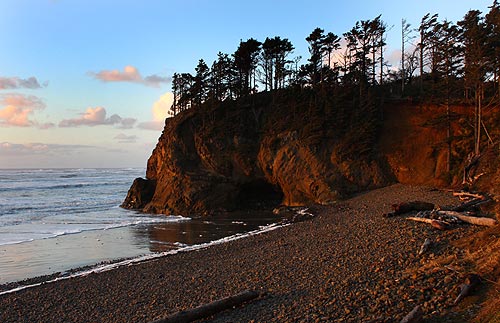Oregon Coast Scientists Warn Warming Ocean Temps May Create Chaos
Published 02/23/2017 at 4:49 AM PDT
By Oregon Coast Beach Connection staff

(Newport, Oregon) – 20 of the world's leading oceanographic researchers today released new evidence indicating how warming ocean temperatures around the globe will create some chaotic changes in that habitat by the year 2100. The deep ocean floor may see starvation and devastating ecological changes by the end of this century, and this will in turn have difficult implications for the rest of the planet.
Among those researchers who were part of the study were Andrew Thurber, an Oregon State University marine ecologist and co-author. This facility does much of its work through the Hatfield Marine Science Center in Newport, on the central Oregon coast. The study's findings were published this week in the journal Elementa.
Thurber said warming ocean temperatures result in the increase of acidification and the spread of low-oxygen zones – something the Oregon coast has already dealt with in the last decade with the notorious “dead zones” that appeared periodically. But it's the biodiversity of all the ocean's deeper depths that are at stake, from 200 to 6,000 meters below the surface.
These ecosystems are only now being understood in how they affect the “functioning of the planet,” Thurber said. The threat begins with less food dropping to the bottom for the creatures that live there, and that at the very least will create enormous problems in the fishing industry. The numerous Earth models researchers used to make projections also pointed to difficulties with the oceans' ability to offset growing amounts of carbon dioxide emitted into the atmosphere.
“Biodiversity in many of these areas is defined by the meager amount of food reaching the seafloor and over the next 80-plus years - in certain parts of the world - that amount of food will be cut in half,” Thurber said.
Some species will migrate, others will die, while still some others will thrive.
Projections saw the seafloor temperatures increasing by as much as four degrees Celsius in some areas.
“While four degrees doesn’t seem like much on land, that is a massive temperature change in these environments,” Thurber said. “It is the equivalent of having summer for the first time in thousands to millions of years.”
Thurber and the other scientists pointed out these regions cover about half the planet.
Pointing to the massive die-off of Dungeness crab off the Oregon coast ten years ago, Thurber noted that was the result of a lack of oxygen rising closer to the surface. The same process could be accelerated in higher regions of the ocean around the world by 2100, killing off food for species there and below.
Andrew Sweetman, a researcher at Heriot-Watt University in Edinburgh and lead author on the study, said this would result in a famine for much of the deep. This ecosystem is already in heavy competition for food sources that are scarce.
The first effect noticeable to humans would be the lack of fish. The North and South Pacific, North and South Atlantic, and North and South Indian oceans would be hit the hardest. Next could be levels of carbon dioxide in the atmosphere. The North Atlantic and its currents would be especially affected by warmer temperatures, acidification and lower oxygen, as this area soaks up carbon from the atmosphere and then the currents distribute it further around the world.
“We think of the deep ocean as incredibly stable and too vast to impact, but it doesn’t take much of a deviation to create a radically altered environment,” Thurber said. Where to stay on the Oregon coast - Where to eat - Maps - Virtual Tours. More on the Oregon coast below:





More About Oregon Coast hotels, lodging.....
More About Oregon Coast Restaurants, Dining.....
Cannon Beach Lodging
Nehalem Bay Lodgings
Manzanita Hotels, Lodging
Three Capes Lodging
Pacific City Hotels, Lodging
Lincoln City Lodging
Depoe Bay Lodging
Newport Lodging
Waldport Lodging
Yachats Lodging
Oregon Coast Vacation Rentals
Oregon Coast Lodging Specials
LATEST Related Oregon Coast Articles
Likely just before dawn best hour but peak happens during daylight. Weather
Dark Sky Week is Prime Along Oregon Coast: Where and Where Not to Go
General guide to dark sky viewing from south to north coast. Astronomy
Sizable Price Drop, Deals in Lincoln City During Quiet of April on Central Or...
20 perc off at A1 Vacation Rentals across its roster, including Gleneden Beach. Lincoln City specials
Upcoming S. Oregon Coast Events Include Gem Show, History: Coos Bay, Bandon
May 6 talk at Coos History Museum, Mayfly Fest May 17, Bandon Rock / Gem Show June 7,8
Washington Coast Cleanup on April 19 - Coinciding with Oregon Coast's SOLVE E...
From the Puget Sound to Long Beach, alongside Oregon's cleanup. Washington coast events, Seaside events
Astoria's Riverwalk Gets New Lighting, More N. Oregon Coast Roadwork
Delays coming this summer, but the riverwalk has a new look. Seaside, Cannn Beach
April Gets Even Cheaper Midweek at Depoe Bay, Lincoln City: Oregon Coast Deals
Off-season rates plus more at Keystone Vacation Rentals. Depoe Bay lodging specials, Lincoln City hotel reviews, Newport hotel reviews
Washington Coast Begins Week of Clam Digs, April 12 Through 18
Long Beach, Twin Harbors, Mocrocks and Copalis at different times. Washington coast events
Back to Oregon Coast
Contact Advertise on BeachConnection.net
All Content, unless otherwise attributed, copyright BeachConnection.net Unauthorized use or publication is not permitted













































